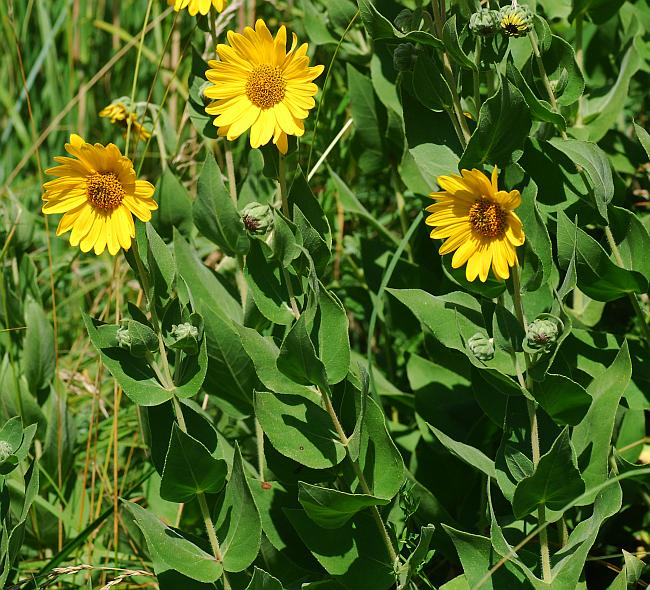Helianthus mollis Lam.
Ashy Sunflower

Native
CC = 6
CW = 5
MOC = 51
© SRTurner
Helianthus mollis Lam.Ashy Sunflower | |
 |
Native CC = 6 CW = 5 MOC = 51 |
© SRTurner |
|
Family - Asteraceae/Heliantheae Habit - Perennial forb with relatively thick, long-creeping, branched rhizomes, usually strongly colonial. Stems - Ascending to erect, to 1.2 m, solitary, moderately to more commonly densely pubescent with short, spreading hairs and usually also shorter, ascending hairs, these mostly not pustular-based, usually appearing uniformly grayish, slightly to moderately roughened to the touch, occasionally nearly glabrous toward the base with age.
Leaves - Opposite, simple, decussate, sessile, clasping, well developed along the stem, usually with 8-17 nodes. Leaf blades 3-15 cm long, 1-7 cm wide, broadly lanceolate to broadly ovate, rounded or shallowly cordate at the base, tapered to a usually sharply pointed tip, the margins entire or less commonly finely toothed, flat, the surfaces pubescent with short, slender, curved or ascending hairs, usually appearing uniformly grayish, slightly to moderately roughened to the touch, often also with sparse to dense, sessile, yellow glands, with 3 main veins, the lateral pair branching from the midnerve well above the base of the blade, arching upward.
Inflorescences - Single flower heads terminating stems, occasionally narrow racemes. Heads - Radiate. Involucre 7-12 mm long, 20-30 mm in diameter, about as long as or slightly longer than the tips of the disc corollas, the bracts in 2-4 somewhat unequal, overlapping series, not tightly appressed, narrowly lanceolate to lanceolate, tapered to a sharply pointed, appressed-ascending or somewhat spreading tip, the margins and outer surface densely pubescent with slender, ascending to somewhat spreading or tangled hairs, also with moderate to dense, minute, sessile, yellow glands. Receptacle convex, the chaffy bracts 9-11 mm long, narrowly oblong to linear, tapered to a sharply pointed, green or straw-colored tip, the outer surface densely short-hairy and glandular.
Flowers - Ray florets 17-30, sterile, the corolla 2.0-3.5 cm long, glabrous or the outer surface with sparse to dense, short, slender hairs and often dense, minute, sessile, yellow glands. Disk to 2.5 cm in diameter. Disc florets perfect, the corollas 6.0-7.5 mm long, yellow or rarely pale yellow, the lobes usually minutely hairy on the outer surface. Pappus of 2 scales 2.5-3.5 mm long, these lanceolate to narrowly triangular, tapered to a sharply pointed, often minutely awnlike tip. Stamens 5, adnate at base of corolla tube. Filaments whitish, glabrous. Anthers dark brown-purple, connate around style, 4 mm long. Style slightly exserted beyond anthers, bifurcate. Stigmas pubescent.
Fruits - Achenes 3-4 mm long, wedge-shaped to obovate, only slightly flattened but usually bluntly 4-angled in cross-section, moderately to densely pubescent with short, ascending hairs when young, only those at the tip persistent at maturity, uniformly dark brown or with fine, darker and lighter brown mottling. Flowering - July - October. Habitat - Prairies, glades, fields, pastures, fencerows, roadsides, railroads. Origin - Native to the U.S. Lookalikes - Broadly, many other species of Helianthus, Silphium, and others within the Asteraceae. Other info. - This sunflower is fairly common in Missouri, less so north of the Missouri River. Beyond Missouri its range is mostly within the U.S. Midwest. It is relatively straightforward to identify, with canescent-grayish foliage, opposite leaves which clasp the stem, and showy heads with yellow rays and disks. The stems often recline when mature, especially in times of drought. The plants can form large colonies with their spreading rhizomes. Oddly enough, I have noticed that the flowers of this plant sometimes face AWAY from the sun. I do not know why. Most sunflowers exhibit heliotropism. Photographs taken off Hwy 19, Ripley County, MO., 7-26-03 (DETenaglia); also at Shaw Nature Reserve, Franklin County, MO, 8-1-2007, Cuivre River State Park, Lincoln County, MO, 8-25-2008, and Young Conservation Area, Jefferson County, MO, 7-27-2013 (SRTurner). |